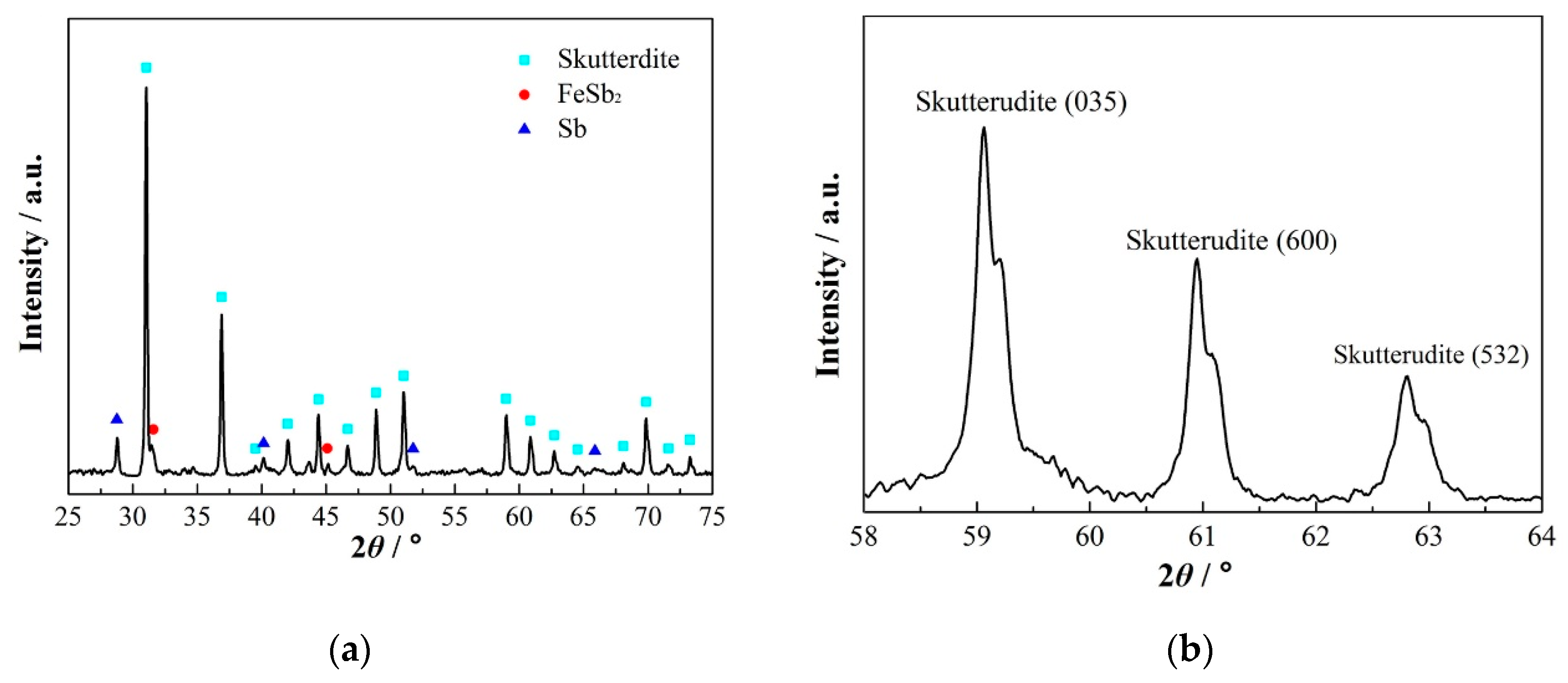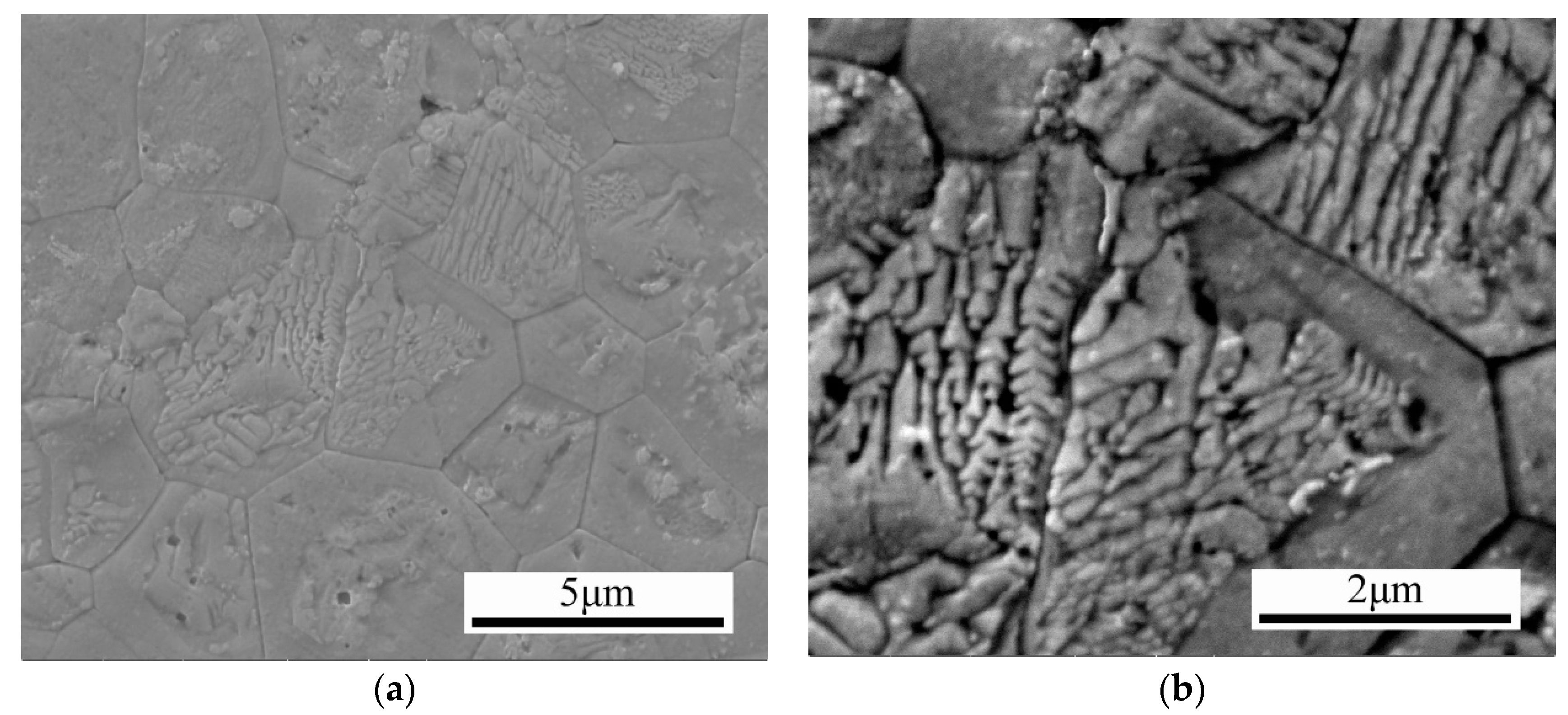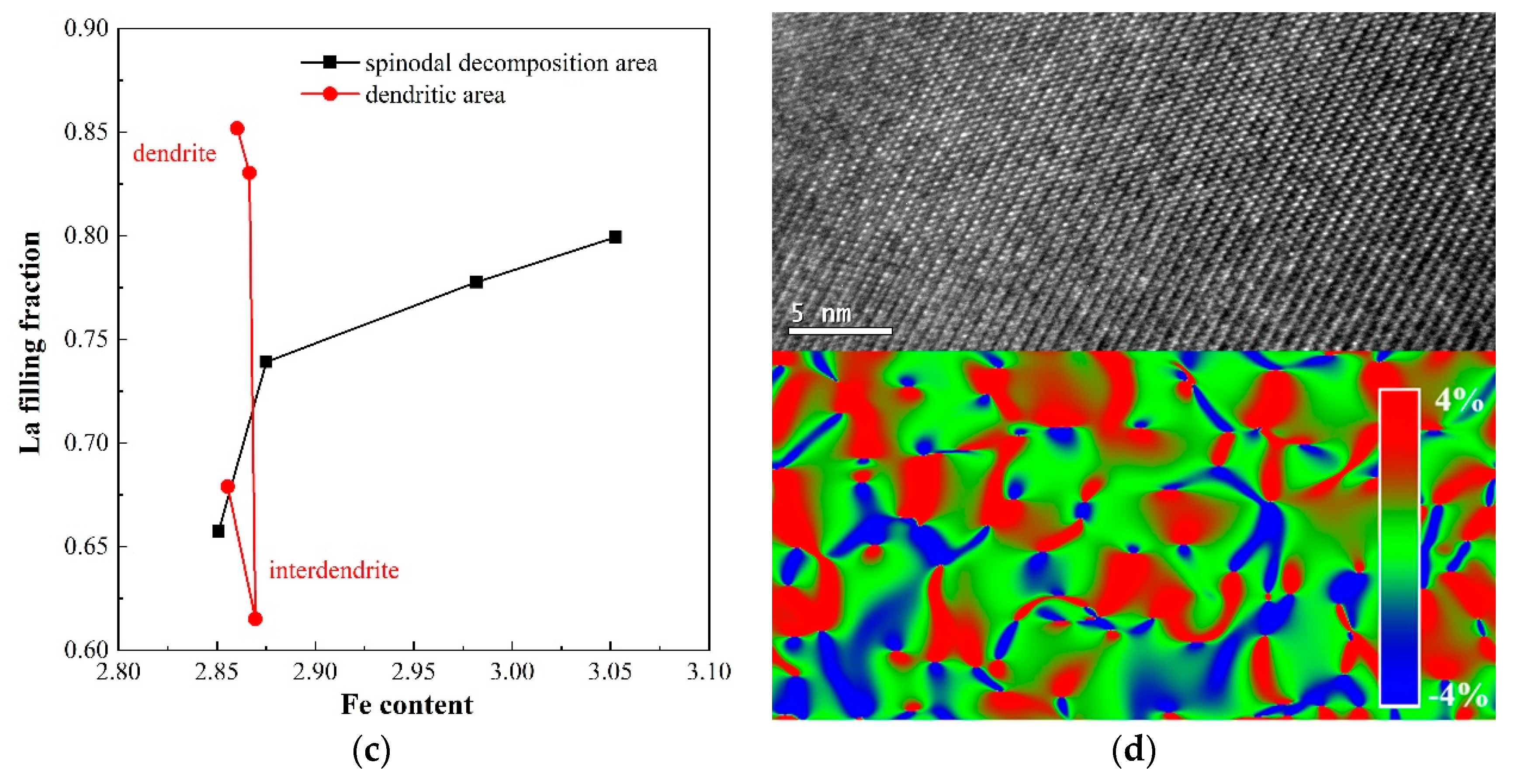Microstructure Evolution and Mechanical Properties of Melt Spun Skutterudite-based Thermoelectric Materials
Abstract
:1. Introduction
2. Materials and Methods
3. Results and Discussions
3.1. The Microstructure of the Annealed Samples
3.2. The Microstructure of the Melt-Spinning Samples
3.3. The Thermoelectric Properties
3.4. The Mechanical Properties
4. Conclusions
Author Contributions
Funding
Acknowledgments
Conflicts of Interest
References
- Jeitschko, W.; Braun, D. LaFe4P12 with filled CoAs3-type structure and isotypic lanthanoid-transition metal polyphosphides. Acta Crystallogr. Sect. B Struct. Crystallogr. Cryst. Chem. 1977, 33, 3401–3406. [Google Scholar] [CrossRef]
- Caillat, T.; Borshchevsky, A.; Fleurial, J.P. Properties of single crystalline semiconducting CoSb3. J. Appl. Phys. 1996, 80, 4442–4449. [Google Scholar] [CrossRef]
- Slack, G.A.; Tsoukala, V.G. Some properties of semiconducting IrSb3. J. Appl. Phys. 1994, 76, 1665–1671. [Google Scholar] [CrossRef]
- Rogl, G.; Rogl, P. Skutterudites, a most promising group of thermoelectric materials. Curr. Opin. Green Sustain. Chem. 2017, 4, 50–57. [Google Scholar] [CrossRef]
- He, J.; Tritt, T.M. Advances in thermoelectric materials research: Looking back and moving forward. Science 2017, 357, eaak9997. [Google Scholar] [CrossRef] [Green Version]
- Snyder, G.J.; Toberer, E.S. Complex thermoelectric materials. Nat. Mater. 2008, 7, 105–114. [Google Scholar] [CrossRef]
- Zhu, T.; Liu, Y.; Fu, C.; Heremans, J.P.; Snyder, J.G.; Zhao, X. Compromise and Synergy in High-Efficiency Thermoelectric Materials. Adv. Mater. 2017, 29, 1605884. [Google Scholar] [CrossRef]
- Muto, A.; Yang, J.; Poudel, B.; Ren, Z.; Chen, G. Skutterudite unicouple characterization for energy harvesting applications. Adv. Energy Mater. 2013, 3, 245–251. [Google Scholar] [CrossRef] [Green Version]
- Geng, H.Y.; Ochi, S.; Guo, J.Q. Solidification contraction-free synthesis for the Yb0.15Co4Sb12 bulk material. Appl. Phys. Lett. 2007, 91, 1–4. [Google Scholar] [CrossRef]
- Wang, H.; Li, S.; Li, X.; Zhong, H. Microstructure and thermoelectric properties of doped p-type CoSb3 under TGZM effect. J. Cryst. Growth 2017, 466, 56–63. [Google Scholar] [CrossRef]
- Shi, X.; Yang, J.; Salvador, J.R.; Chi, M.; Cho, J.Y.; Wang, H.; Bai, S.; Yang, J.; Zhang, W.; Chen, L. Multiple-filled skutterudites: High thermoelectric figure of merit through separately optimizing electrical and thermal transports. J. Am. Chem. Soc. 2011, 133, 7837–7846. [Google Scholar] [CrossRef] [PubMed]
- Sales, B.; Mandrus, D.; Chakoumakos, B.; Keppens, V.; Thompson, J. Filled skutterudite antimonides: Electron crystals and phonon glasses. Phys. Rev. B Condens. Matter Mater. Phys. 1997, 56, 15081–15089. [Google Scholar] [CrossRef]
- Rogl, G.; Grytsiv, A.; Rogl, P.; Peranio, N.; Bauer, E.; Zehetbauer, M.; Eibl, O. N-Type skutterudites (R,Ba,Yb)yCo4Sb12 (R = Sr, La, Mm, DD, SrMm, SrDD) approaching ZT ≈ 2.0. Acta Mater. 2014, 63, 30–43. [Google Scholar] [CrossRef]
- Li, G.; Bajaj, S.; Aydemir, U.; Hao, S.; Xiao, H.; Goddard, W.A.; Zhai, P.; Zhang, Q.; Snyder, G.J. P-Type Co Interstitial Defects in Thermoelectric Skutterudite CoSb3 Due to the Breakage of Sb4-Rings. Chem. Mater. 2016, 28, 2172–2179. [Google Scholar] [CrossRef] [Green Version]
- Jech, R.W.; Moore, T.J.; Glasgow, T.K.; Orth, N.W. Rapid Solidification Via Melt Spinning: Equipment and Techniques. JOM J. Miner. Met. Mater. Soc. 1984, 36, 41–45. [Google Scholar] [CrossRef]
- Nagashio, K.; Kuribayashi, K. Experimental verification of ribbon formation process in chill-block melt spinning. Acta Mater. 2006, 54, 2353–2360. [Google Scholar] [CrossRef]
- Zhang, X.; Atrens, A. Rapid solidification characteristics in melt spinning. Mater. Sci. Eng. A 1992, 159, 243–251. [Google Scholar] [CrossRef]
- Li, H.; Tang, X.; Zhang, Q.; Uher, C. High performance InxCeyCo4Sb12 thermoelectric materials with in situ forming nanostructured InSb phase. Appl. Phys. Lett. 2009, 94, 10–13. [Google Scholar] [CrossRef]
- Tan, G.; Liu, W.; Wang, S.; Yan, Y.; Li, H.; Tang, X.; Uher, C. Rapid preparation of CeFe4Sb12 skutterudite by melt spinning: Rich nanostructures and high thermoelectric performance. J. Mater. Chem. A 2013, 1, 12657–12668. [Google Scholar] [CrossRef]
- Lee, S.; Lee, K.H.; Kim, Y.M.; Kim, H.S.; Snyder, G.J.; Baik, S.; Kim, S.W. Simple and efficient synthesis of nanograin structured single phase filled skutterudite for high thermoelectric performance. Acta Mater. 2018, 142, 8–17. [Google Scholar] [CrossRef]
- Aversano, F.; Branz, S.; Bassani, E.; Fanciulli, C.; Ferrario, A.; Boldrini, S.; Baricco, M.; Castellero, A. Effect of rapid solidification on the synthesis and thermoelectric properties of Yb-filled Co4Sb12 skutterudite. J. Alloy. Compd. 2019, 796, 33–41. [Google Scholar] [CrossRef]
- Guo, L.; Wang, G.; Peng, K.; Yan, Y.; Tang, X.; Zeng, M.; Dai, J.; Wang, G.; Zhou, X. Melt spinning synthesis of p-type skutterudites: Drastically speed up the process of high performance thermoelectrics. Scr. Mater. 2016, 116, 26–30. [Google Scholar] [CrossRef]
- Son, G.; Lee, K.H.; Park, H.W.; Caron, A.; Kim, I.H.; Lee, S.; Choi, S.M. Control of electrical to thermal conductivity ratio for p-type LaxFe3CoSb12 thermoelectrics by using a melt-spinning process. J. Alloy. Compd. 2017, 729, 1209–1214. [Google Scholar] [CrossRef]
- Tan, H.; Zhang, B.; Wang, G.; Chen, Y.; Shen, X.; Guo, L.; Han, X.; Lu, X.; Zhou, X. Rapid preparation of Ge0.9Sb0.1Te1+x via unique melt spinning: Hierarchical microstructure and improved thermoelectric performance. J. Alloy. Compd. 2019, 774, 129–136. [Google Scholar] [CrossRef]
- Thomas, R.; Rao, A.; Chauhan, N.S.; Vishwakarma, A.; Singh, N.K.; Soni, A. Melt spinning: A rapid and cost effective approach over ball milling for the production of nanostructured p-type Si80Ge20 with enhanced thermoelectric properties. J. Alloy. Compd. 2019, 781, 344–350. [Google Scholar] [CrossRef]
- Meng, X.; Cai, W.; Liu, Z.; Li, J.; Geng, H.; Sui, J. Enhanced thermoelectric performance of p-type filled skutterudites via the coherency strain fields from spinodal decomposition. Acta Mater. 2015, 98, 405–415. [Google Scholar] [CrossRef]
- Ren, W.; Geng, H.; Zhang, L.; Liu, X.; He, T.; Feng, J. Simultaneous blocking of minority carrier and high energy phonon in p-type skutterudites. Nano Energy 2018, 46, 249–256. [Google Scholar] [CrossRef]
- Ren, W.; Geng, H.; Zhang, Z.; Zhang, L. Filling-Fraction Fluctuation Leading to Glasslike Ultralow Thermal Conductivity in Caged Skutterudites. Phys. Rev. Lett. 2017, 118, 1–6. [Google Scholar] [CrossRef]
- Geng, H.; Ochi, T.; Suzuki, S.; Kikuchi, M.; Ito, S.; Guo, J. Thermoelectric properties of multifilled skutterudites with la as the main filler. J. Electron. Mater. 2013, 42, 1999–2005. [Google Scholar] [CrossRef]
- Guo, J.Q.; Geng, H.Y.; Ochi, T.; Suzuki, S.; Kikuchi, M.; Yamaguchi, Y.; Ito, S. Development of skutterudite thermoelectric materials and modules. J. Electron. Mater. 2012, 41, 1036–1042. [Google Scholar] [CrossRef]
- Otooni, M.A. Elements of Rapid Solidification; Springer: New York, NY, USA, 1998; pp. 26–27. [Google Scholar]
- Kramer, M.J.; Lewis, L.H.; Fabietti, L.M.; Tang, Y.; Miller, W.; Dennis, K.W.; McCallum, R.W. Solidification, microstructural refinement and magnetism in Nd2Fe14B. J. Magn. Magn. Mater. 2002, 241, 144–155. [Google Scholar] [CrossRef]
- Kramer, M.J.; Lewis, L.H.; Tang, Y.; Dennis, K.W.; McCallum, R.W. Microstructural refinement in melt-spun Nd2Fe14B. Scr. Mater. 2002, 47, 557–562. [Google Scholar] [CrossRef]
- Serrano-Sánchez, F.; Prado-Gonjal, J.; Nemes, N.M.; Biskup, N.; Varela, M.; Dura, O.J.; Martínez, J.L.; Fernández-Díaz, M.T.; Fauth, F.; Alonso, J.A. Low thermal conductivity in La-filled cobalt antimonide skutterudites with an inhomogeneous filling factor prepared under high-pressure conditions. J. Mater. Chem. A 2017, 6, 118–126. [Google Scholar] [CrossRef] [Green Version]
- Serrano-Sánchez, F.; Prado-Gonjal, J.; Nemes, N.M.; Biskup, N.; Dura, O.J.; Martínez, J.L.; Fernández-Díaz, M.T.; Fauth, F.; Alonso, J.A. Thermal Conductivity Reduction by Fluctuation of the Filling Fraction in Filled Cobalt Antimonide Skutterudite Thermoelectrics. ACS Appl. Energy Mater. 2018, 1, 6181–6189. [Google Scholar] [CrossRef]
- Gainza, J.; Serrano-Sánchez, F.; Prado-Gonjal, J.; Nemes, N.M.; Biskup, N.; Dura, O.J.; Martínez, J.L.; Fauth, F.; Alonso, J.A. Substantial thermal conductivity reduction in mischmetal skutterudites Mm: XCo4Sb12 prepared under high-pressure conditions, due to uneven distribution of the rare-earth elements. J. Mater. Chem. C 2019, 7, 4124–4131. [Google Scholar] [CrossRef] [Green Version]
- Yang, J.; Qiu, P.; Liu, R.; Xi, L.; Zheng, S.; Zhang, W.; Chen, L.; Singh, D.J.; Yang, J. Trends in electrical transport of p-type skutterudites RFe 4Sb 12 (R = Na, K, Ca, Sr, Ba, La, Ce, Pr, Yb) from first-principles calculations and Boltzmann transport theory. Phys. Rev. B Condens. Matter Mater. Phys. 2011, 84, 235205. [Google Scholar] [CrossRef]
- Grosvenor, A.P.; Cavell, R.G.; Mar, A. X-ray photoelectron spectroscopy study of the skutterudites LaFe4Sb12, CeFe4Sb12, CoSb3, and CoP3. Phys. Rev. B Condens. Matter Mater. Phys. 2006, 74, 125102. [Google Scholar] [CrossRef]
- Sun, B.; Liu, R.; Gu, B. Numerical simulation of three-point bending fatigue of four-step 3-D braided rectangular composite under different stress levels from unit-cell approach. Comput. Mater. Sci. 2012, 65, 239–246. [Google Scholar] [CrossRef]












| No. | Actual Chemical Composition |
|---|---|
| 1 | La0.80Ti0.1Ga0.1Fe3.10Co0.90Sb12 |
| 2 | La0.75Ti0.1Ga0.1Fe2.90Co1.10Sb12 |
| 3 | La0.75Ti0.1Ga0.1Fe2.90Co1.10Sb12 |
| 4 | La0.60Ti0.1Ga0.1Fe2.62Co1.38Sb12 |
| 5 | La0.70Ti0.1Ga0.1Fe2.82Co1.18Sb12 |
| 6 | La0.65Ti0.1Ga0.1Fe2.70Co1.30Sb12 |
© 2020 by the authors. Licensee MDPI, Basel, Switzerland. This article is an open access article distributed under the terms and conditions of the Creative Commons Attribution (CC BY) license (http://creativecommons.org/licenses/by/4.0/).
Share and Cite
Geng, H.; Zhang, J.; He, T.; Zhang, L.; Feng, J. Microstructure Evolution and Mechanical Properties of Melt Spun Skutterudite-based Thermoelectric Materials. Materials 2020, 13, 984. https://doi.org/10.3390/ma13040984
Geng H, Zhang J, He T, Zhang L, Feng J. Microstructure Evolution and Mechanical Properties of Melt Spun Skutterudite-based Thermoelectric Materials. Materials. 2020; 13(4):984. https://doi.org/10.3390/ma13040984
Chicago/Turabian StyleGeng, Huiyuan, Jialun Zhang, Tianhong He, Lixia Zhang, and Jicai Feng. 2020. "Microstructure Evolution and Mechanical Properties of Melt Spun Skutterudite-based Thermoelectric Materials" Materials 13, no. 4: 984. https://doi.org/10.3390/ma13040984
APA StyleGeng, H., Zhang, J., He, T., Zhang, L., & Feng, J. (2020). Microstructure Evolution and Mechanical Properties of Melt Spun Skutterudite-based Thermoelectric Materials. Materials, 13(4), 984. https://doi.org/10.3390/ma13040984




